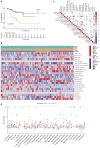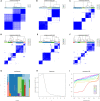Characterization of the immune cell infiltration landscape in myxofibrosarcoma to aid immunotherapy
- PMID: 35936000
- PMCID: PMC9353264
- DOI: 10.3389/fimmu.2022.916915
Characterization of the immune cell infiltration landscape in myxofibrosarcoma to aid immunotherapy
Abstract
Myxofibrosarcoma (MFS) is a highly malignant subtype of soft tissue sarcoma, accounting for 5% of cases. Immunotherapy guided by immune cell infiltration (ICI) is reportedly a promising treatment strategy. Here, MFS samples (n = 104) from two independent databases were classified as ICI clusters A/B/C and gene clusters A/B/C. Then, a close relationship between ICI and gene clusters was established. We found that the features of these clusters were consistent with the characteristics of immune-inflamed tumors (cluster C), immune-desert tumors (cluster B), and immune-excluded tumors (cluster A). Moreover, cluster C was sensitive to immunotherapy. Finally, an independent ICI score was established to predict the therapeutic effect, which has prospects for application in guiding immunotherapy during clinical practice.
Keywords: ICI; MFS; TME; immunotherapy; prognosis.
Copyright © 2022 Zhao, Chen, Yu, Xiao, Liu, Xia, Li, Wang, Xiang, Liu, Yang, Li and Xiao.
Conflict of interest statement
The authors declare that the research was conducted in the absence of any commercial or financial relationships that could be construed as a potential conflict of interest.
Figures







Similar articles
-
Identification of the immune cell infiltration landscape in pancreatic cancer to assist immunotherapy.Future Oncol. 2021 Nov;17(31):4131-4143. doi: 10.2217/fon-2021-0495. Epub 2021 Aug 4. Future Oncol. 2021. PMID: 34346253
-
Characterization of the immune cell infiltration landscape in bladder cancer to aid immunotherapy.Arch Biochem Biophys. 2021 Sep 15;708:108950. doi: 10.1016/j.abb.2021.108950. Epub 2021 Jun 9. Arch Biochem Biophys. 2021. PMID: 34118215
-
Landscape of Immune Microenvironment Under Immune Cell Infiltration Pattern in Breast Cancer.Front Immunol. 2021 Aug 27;12:711433. doi: 10.3389/fimmu.2021.711433. eCollection 2021. Front Immunol. 2021. PMID: 34512634 Free PMC article.
-
The Biology of Myxofibrosarcoma: State of the Art and Future Perspectives.Oncol Res Treat. 2020;43(6):314-322. doi: 10.1159/000507334. Epub 2020 May 25. Oncol Res Treat. 2020. PMID: 32450554 Review.
-
Immune microenvironment infiltration landscape and immune-related subtypes in prostate cancer.Front Immunol. 2023 Jan 9;13:1001297. doi: 10.3389/fimmu.2022.1001297. eCollection 2022. Front Immunol. 2023. PMID: 36700224 Free PMC article. Review.
Cited by
-
Giant myxofibrosarcoma of neck: A case report and review of the literature.Medicine (Baltimore). 2025 Apr 18;104(16):e42150. doi: 10.1097/MD.0000000000042150. Medicine (Baltimore). 2025. PMID: 40258773 Free PMC article. Review.
References
Publication types
MeSH terms
Substances
LinkOut - more resources
Full Text Sources

